The Vision and Development of the Bugatti Chiron
The Bugatti Chiron didn’t just appear out of thin air. Its creators had one mission: outdo the legendary Veyron and set the bar even higher for hypercars.
They named it after Louis Chiron, a racing legend. The whole project revolved around wild engineering ideas and tech that sounded almost unreal at the time.
Origins and Inspiration
Bugatti wanted the Chiron to be more than just a sequel to the Veyron. They aimed to shatter boundaries in automotive engineering, not just nudge them.
Louis Chiron Legacy
Louis Chiron, the Monegasque ace who tore up tracks for Bugatti from 1926 to 1933, lent his name to this beast. It followed Bugatti’s tradition—remember the Veyron, named for Pierre Veyron?
Volkswagen’s Vision
Volkswagen Group, Bugatti’s parent company, basically handed the team a blank check. With those resources, they chased after hypercar performance like it was a holy grail. (hypercar performance)
They wanted the Chiron to be a rolling showcase of luxury, craftsmanship, and everything that makes Bugatti, well, Bugatti. Premium materials? Absolutely. Obsessive attention to detail? You bet.
Development Challenges and Solutions
Building the Chiron wasn’t a walk in the park. The team ran into all sorts of wild engineering headaches—especially with cooling, aerodynamics, and keeping the whole thing from shaking itself apart.
Cooling System Innovation
Taming the monstrous W-16 engine meant fighting a losing battle against heat—until they didn’t. The solution? Ten radiators. Three for the engine, others for transmission and rear differential oil, and so on.
Picture this: 211 gallons of water whipping through the system every minute. The engine gulps down 2,118 cubic feet of air per minute. That’s not just engineering; it’s borderline wizardry.
Carbon Fiber Construction
The chassis? It devours over 3,000 square feet of carbon fiber. Lay those fibers end-to-end, and you could reach the moon and back—four times. That’s not an exaggeration, it’s just Bugatti being dramatic (and we love it).
Hydraulic Systems
Eighteen hydraulic cylinders keep the Chiron’s active aerodynamic tricks running smoothly. The air brake? Pure theater, but it works.
Debut at the Geneva Motor Show
When Bugatti finally yanked the covers off the Chiron at the 2016 Geneva Motor Show, jaws hit the floor. It was a moment—one of those “where were you when…” kind of deals in the car world.
Initial Specifications
The debut model roared out with 1,480 horsepower and 1,180 lb-ft of torque, all from that 8.0-liter quad-turbo W-16. Numbers like those don’t just make headlines—they make history.
Public Reception
Collectors and enthusiasts lost their minds. The Chiron’s looks and performance didn’t just turn heads; they made people rethink what a hypercar could be.
Geneva proved Bugatti was back on top. The Chiron wasn’t just another supercar—it felt like the future, right there under the show lights.
Behind-the-Scenes Stories
Every Chiron is a hand-built masterpiece. The level of obsession in the manufacturing process is, honestly, a little intimidating.
Manufacturing Process
At Bugatti’s Molsheim factory, workers tighten 3,800 screws per car. Painting alone takes three painstaking weeks, layer by layer.
From start to finish, each Chiron takes about six months to build. That includes brutal quality control and endless little tweaks.
Limited Production Planning
Bugatti only planned 500 Chirons from the get-go. Now, with just 40 slots left, the end is in sight—production runs through 2022.
The last few cars? Pur Sport and Super Sport models, with the Centodieci (a wild throwback to the ’90s EB 110) joining the lineup for good measure.
Engine and Performance Breakthroughs
This is where the Chiron gets truly bonkers. The 8.0-liter quad-turbo W16 isn’t just a powerhouse—it’s an engineering flex, producing up to 1,578 horsepower. Pair that with advanced cooling and relentless reliability, and you’ve got a monster that’s as refined as it is ferocious. (unprecedented performance)
Quad-Turbocharged W16 Engine Evolution
They started with the Veyron’s blueprint, then tore it up. The Chiron’s W16 got a new block, new internals, and a whole new attitude.
Four turbochargers work in pairs—two for low-speed punch, two more for high-speed insanity. Turbo lag? Not here. The power just keeps coming, like a freight train with no brakes.
The W16’s compact design fits 16 cylinders into the Chiron’s body. Each bank has its own cooling and fuel system, which is just… wild.
Bugatti beefed up everything inside—pistons, rods, crankshaft. New materials and tech make it nearly indestructible. Or at least, that’s the plan.
The engine’s brain monitors thousands of things every second—temp, pressure, fuel flow. It’s always optimizing, always on edge. No room for mistakes at this level.
Powertrain and 8.0-Liter W16 Specifications
The 8.0-liter W16 cranks out 1,479 hp in the “standard” Chiron. The Super Sport? That’s 1,578 hp. Torque? A face-melting 1,180 lb-ft, no matter the variant.
| Specification | Standard Chiron | Super Sport |
|---|---|---|
| Power | 1,479 hp | 1,578 hp |
| Torque | 1,180 lb-ft | 1,180 lb-ft |
| Fuel System | Direct injection | Direct injection |
| Compression Ratio | 9.0:1 | 9.0:1 |
All that power runs through a 7-speed dual-clutch transmission. Gear changes happen so fast, you’ll barely notice—except for the g-force.
All-wheel drive keeps the Chiron glued to the road. The system shuffles power front to rear, left to right, always looking for grip. Computers handle the chaos.
It drinks only the best—93-octane gas. Fuel economy? Frankly, who cares, but it’s 9 mpg city and 14 highway. The tank holds 26.4 gallons, so at least you’ll go far between fill-ups (sort of).
Top Speed and Acceleration
Zero to 60 mph? Just 2.3 seconds. Blink and you’ll miss it. 124 mph comes up in 6.1 seconds. It’s almost silly how quick it is.
Top speed is where things get mythic. The regular Chiron is capped at 261 mph—because, you know, safety. The Super Sport? It broke the 300 mph barrier, clocking 304 mph at Ehra-Lessien in Germany.
That record run needed special Michelin tires, custom-made to survive the punishment. They’re crazy expensive and don’t last long, but hey, that’s the price of glory.
Aerodynamics are everything at those speeds. The Chiron slices through air, and its active aero bits constantly adapt. It’s like the car’s fighting physics and winning.
Cooling Systems and Reliability
All that power generates heat like a blast furnace. The Chiron uses ten radiators—each with its own job, cooling the engine, transmission, even the turbochargers.
The main cooling circuit uses a massive radiator and electric fans. Coolant snakes through the block and heads, keeping temps steady even when you’re pushing the limit.
Turbocharger cooling gets its own system, with dedicated pumps and heat exchangers. Overheating? Not on Bugatti’s watch.
The transmission has its own oil coolers and pumps, too. That way, gear changes stay buttery smooth, no matter how hard you drive.
Bugatti built the Chiron’s engine to last, even under relentless abuse. High-grade materials, tight tolerances, and obsessive testing mean you can actually drive this thing, not just look at it.
Exterior Styling and Aerodynamic Innovations
The Chiron doesn’t just look fast—it is fast, and every curve, vent, and crease has a job to do. The design is bold, dramatic, and absolutely unmistakable. (advanced aerodynamic engineering) (exceptional performance)
Carbon Fibre Monocoque Construction
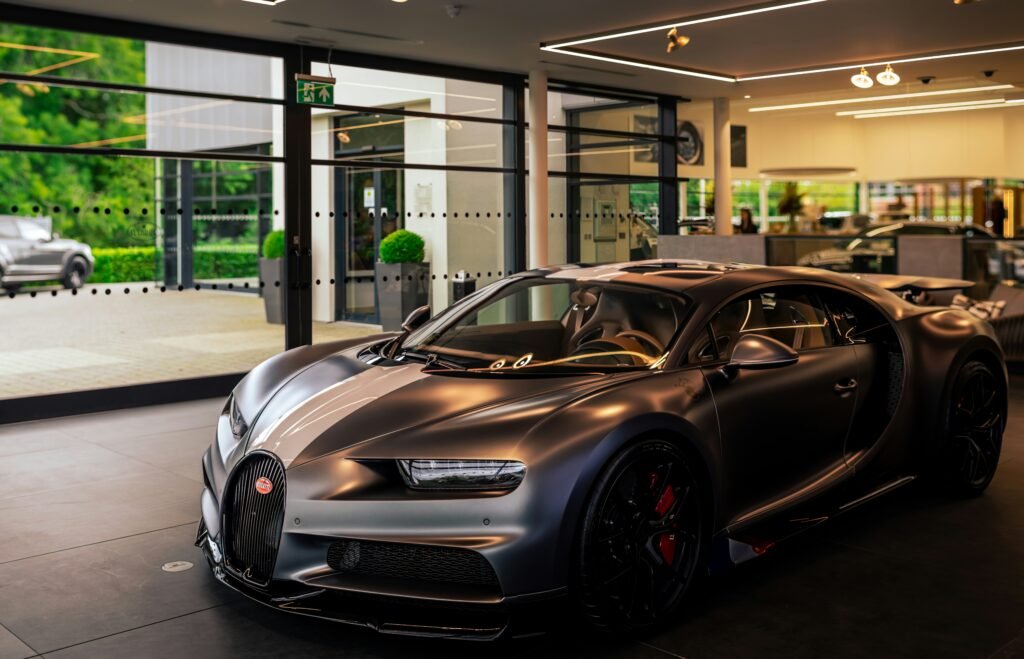
Underneath, the Chiron’s skeleton is pure carbon fiber. The monocoque chassis is a single-piece marvel—light, strong, and built like a supercar should be.
Carbon fiber slashes weight by 75% compared to steel, but keeps things rock-solid. No separate frame pieces needed here.
Bugatti uses pre-preg carbon fiber layups, ensuring every strand sits exactly where it should. The monocoque stretches from the front all the way to the rear engine bay.
This structure is the anchor for everything else—body panels, suspension, aero bits. The result? A car that feels carved from a single block.
Key benefits include:
- Weight savings that make a difference
- Structural rigidity you can feel
- Crash protection that’s reassuring
- Aero efficiency that’s borderline magic
With carbon fiber, Bugatti sculpts the Chiron’s body into a wind-cheating missile. At 250+ mph, every fraction of a percent matters.
Aerodynamics and Active Systems
The Chiron bristles with active aero tech. These systems are always adjusting, always finding that sweet spot between downforce and drag.
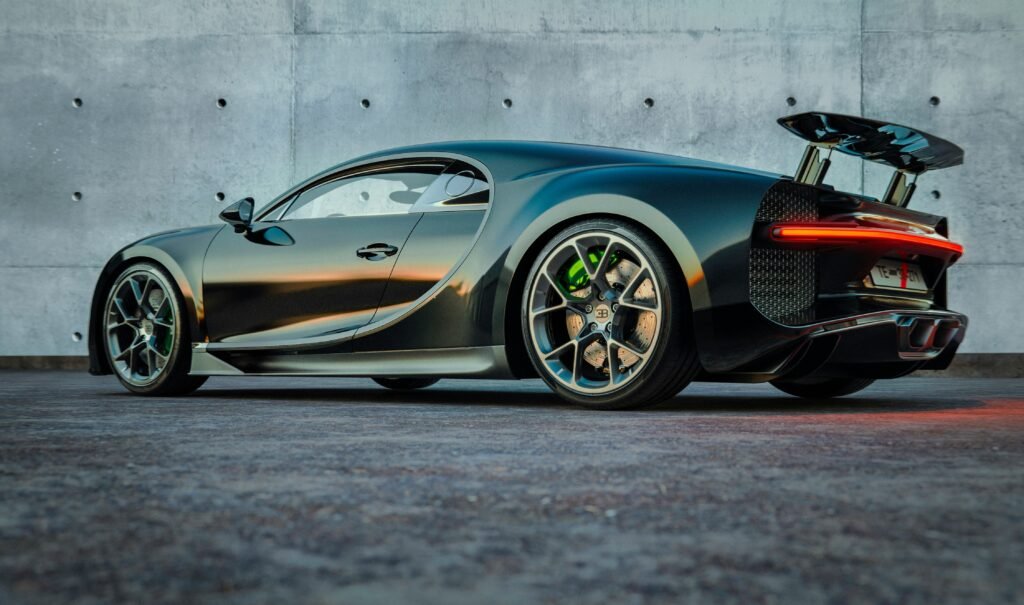
The rear wing? It’s a party trick and a necessity. Flat at low speeds, then rising and tilting when you really put your foot down.
Above 150 mph, the wing goes full “hold on tight.” The front air dam drops, squeezing airflow and keeping the car planted.
Active aerodynamic components:
- Rear wing that moves with purpose
- Front splitter that adapts
- Air dam that knows when to duck
- Cooling vents that open and close as needed
All these parts work together, making sure the Chiron doesn’t just go fast—it stays glued to the tarmac, no matter what.
Signature Design Elements
From the outside, the Chiron is pure Bugatti—heritage with a modern twist. The horseshoe grille up front is iconic, instantly recognizable.
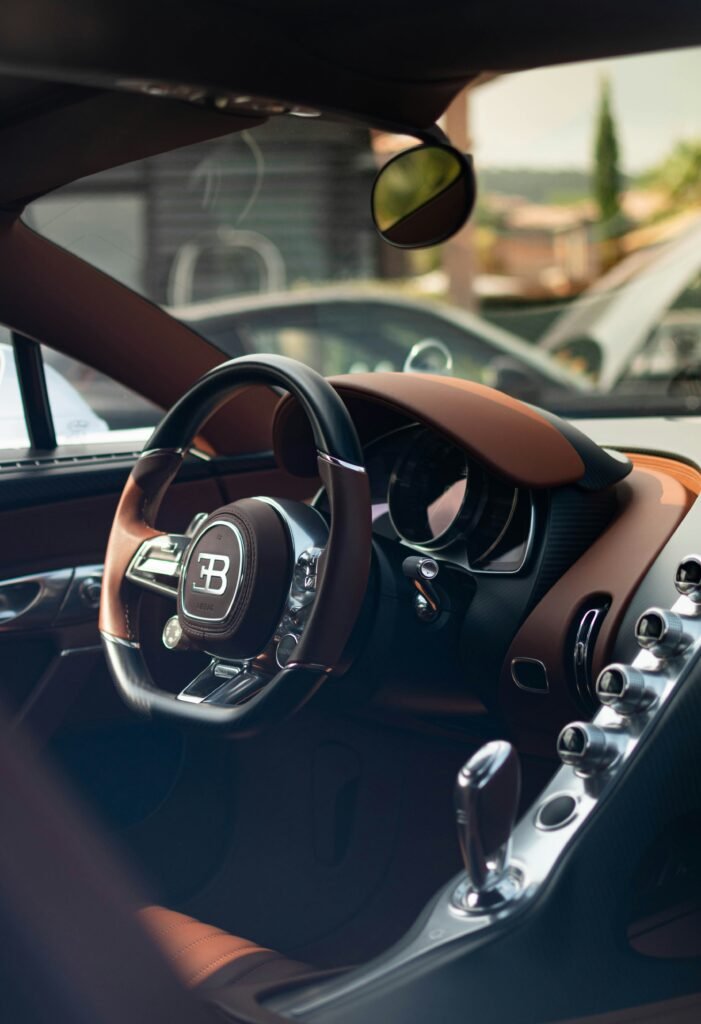
LED headlights wrap around the corners in a dramatic C-shape. It’s a look that says, “You know what this is.”
The side profile is all about that bold character line, stretching from nose to tail. It gives the car a sense of motion, even at a standstill.
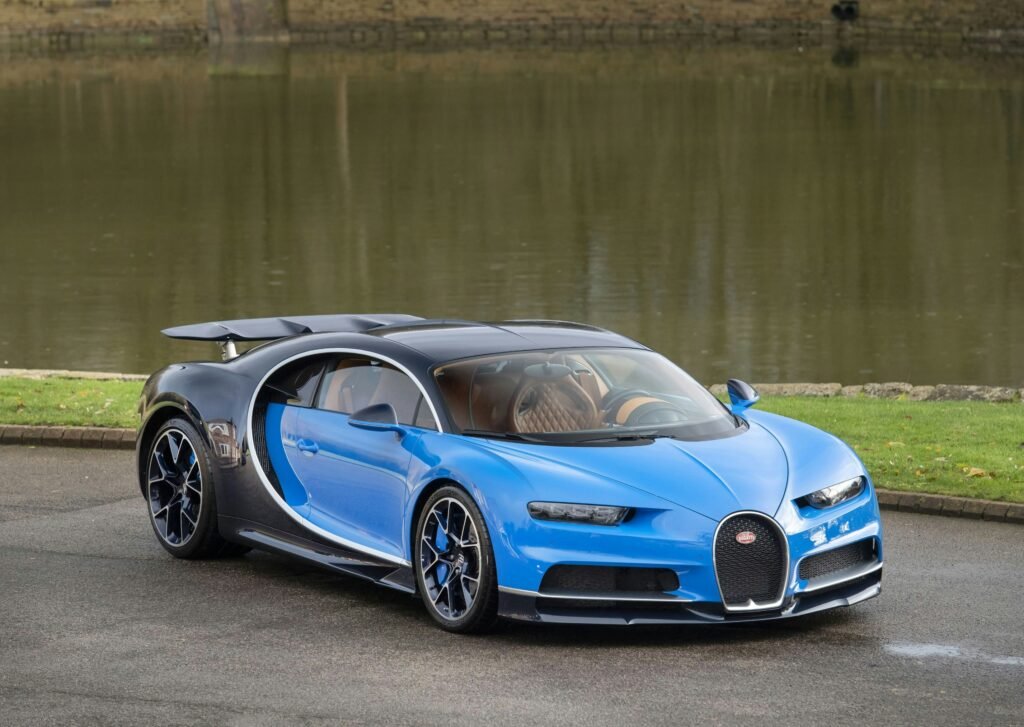
Functional air intakes sculpt the sides, feeding the engine and cooling systems. Nothing’s there just for show—every vent has a purpose.
Out back, quad exhausts and a massive diffuser declare war on boring design. The taillights echo the front’s C-shape, tying the whole look together.
Since we are on the topic of the exhaust you need to listen to this car’s incredible cold start
Distinctive elements include:
- That unmistakable horseshoe grille
- C-shaped LED lights that mean business
- Side intakes that actually work
- Quad exhausts for a proper send-off
Front Splitter and Air Curtain Technology
The Chiron’s front splitter sticks out beneath the front bumper, grabbing airflow and shoving it under the car. That thing creates a high-pressure zone, which—let’s be honest—helps squash lift and keeps the nose pinned down.
Air curtain technology does its own magic, guiding air around the front wheels. Vertical slots in the bumper send air through special ducts, almost like secret passageways for wind.
The air curtains cut down on the turbulence that spinning wheels throw up. Thanks to this, the Chiron gets a 3-5% bump in aerodynamic efficiency. Not too shabby for something you can’t even see working.
The front splitter and air curtains team up, smoothing out airflow as it moves over the splitter, through the curtains, and along the car’s sides. It’s almost like they’re choreographing a dance with the wind.
These features really come alive at higher speeds. The faster you go, the more air they wrangle, slashing turbulence and drag even further.
Active and passive aero elements join forces, letting the Chiron blast up to 261 mph and still feel like it’s glued to the tarmac. That’s not just engineering—it’s a bit of black magic.
Interior Craftsmanship and Comfort
The Bugatti Chiron’s interior? It’s a love letter to luxury and obsessive engineering. Nearly every surface wears fine leather, while carbon fiber and aluminum details turn the cabin into a blend of comfort and race-ready cool.
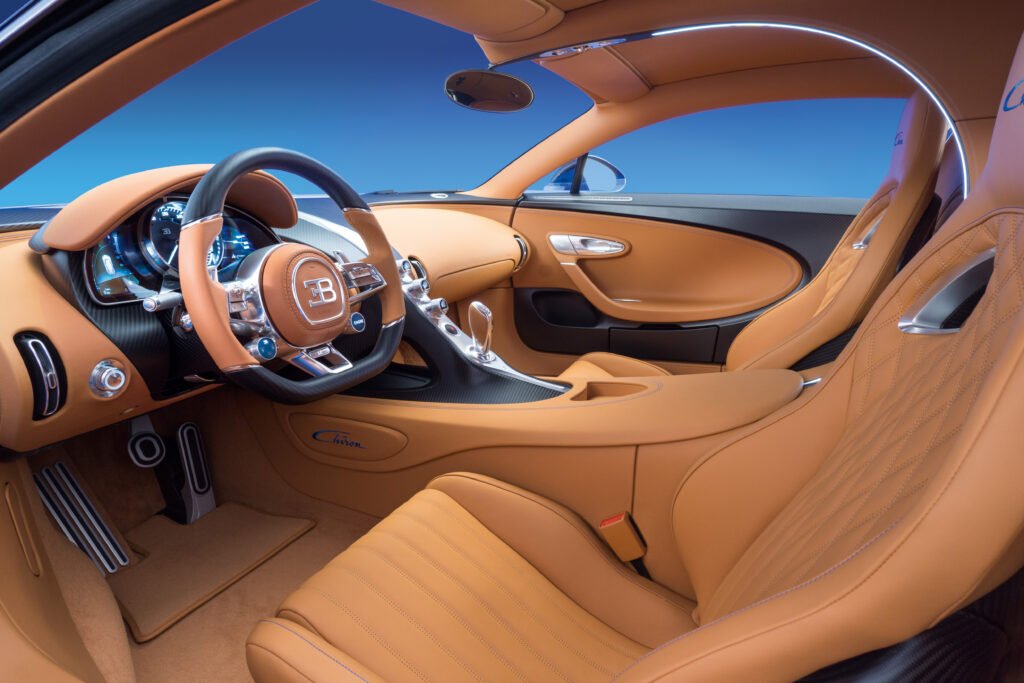
Luxury Materials and Customization
Step inside, and it’s obvious: the Chiron uses some of the best materials you’ll ever find in a car. The leather wraps the dashboard, seats, and doors—looks gorgeous, feels even better.
Carbon fiber pops up everywhere, adding a touch of modern sculpture while keeping the weight down. Aluminum accents? They shimmer just enough to catch your eye without screaming for attention.
Bugatti’s customization game is wild. Buyers get to pick leather colors, textures, carbon fiber weaves, and metal finishes—it’s like building your own luxury spaceship.
The craftsmanship here? Honestly, it’s furniture-grade. Every piece gets hand-fitted, and the stitching is so precise you’d think they used a ruler and a magnifying glass.
Driver-Centric Design
The Chiron’s cockpit is all about the driver. Forget crowded button clusters—everything’s streamlined and right where you need it.
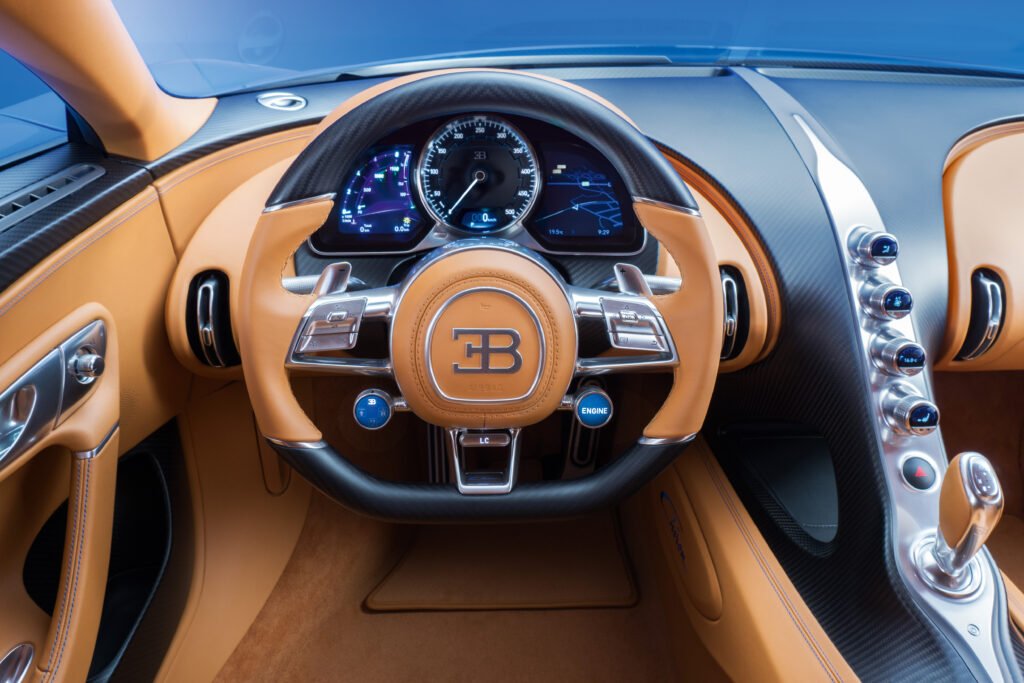
The dashboard flows with gentle curves, ditching harsh angles. It’s calming, even when you’re flying down the highway at three times the speed limit. Storage spaces stay hidden, keeping things tidy.
The seats hug you tight but stay comfortable, with padding that feels just right. The driving position? Spot on. You see every gauge and reach every switch without stretching.
Even the door panels stick to the minimalist vibe. Controls are there, but they don’t clutter things up. Plus, those soft-touch materials? They make every contact point feel special.
Technology Features
Tech-wise, the Chiron nails it. A central display runs entertainment and car settings, but it keeps things simple—no endless menus to distract you from the road.
Digital gauges show speed and engine data with crisp, high-res screens. Sun glare? Doesn’t matter. The info sits right in your line of sight, so you never miss a beat.
Climate control works quietly in the background, automatically keeping things comfy. Both driver and passenger can dial in their own temps—no fighting over the settings.
Sound insulation is top-notch. Even at highway speeds, you can chat or crank up the music without the outside world barging in. It’s like a rolling sanctuary.
Iconic Variants and Special Editions
Bugatti didn’t stop at one Chiron. They rolled out 17 versions, each with its own personality. The Super Sport chased top speed records, while the Pur Sport was all about track thrills and razor-sharp handling.
Chiron Super Sport
The Chiron Super Sport? That’s Bugatti chasing the horizon. They stretched the rear by 25 centimeters, giving it that long-tail look that just screams speed.
The new tail isn’t just for show. It slices through the air, cutting drag and keeping the car steady when you’re pushing the limits.
Key specifications:
- Top speed: 304.773 mph (490.484 km/h)
- Power output: 1,578 horsepower
- Length increase: 25 cm over standard Chiron
The Super Sport smashed speed records, hitting over 304 mph at Ehra-Lessien. Fastest production car ever tested? Absolutely.
They only made 30 of these monsters, and each one cost about $3.9 million. Not exactly pocket change.
Chiron Pur Sport
The Pur Sport? That’s the Chiron’s wild child—built for the track, not just straight-line bragging rights. Engineers stripped out 50 kilograms using carbon fiber and a more bare-bones interior.
Performance modifications:
- Shorter gear ratios for quicker acceleration
- Stiffer suspension setup
- Larger rear wing for increased downforce
- Top speed: Limited to 218 mph
The Pur Sport delivers a whopping 1,200 kilograms of downforce at v-max. That means it corners like it’s on rails—way more agile than the standard Chiron.
Bugatti built just 60 of these. Price tag? Starts at $3.6 million. If you blinked, you missed your chance.
Limited-Run Models
Bugatti also cooked up some seriously rare Chirons. Special editions marked milestones or paid tribute to racing legends.
The Chiron Sport was a bit more common, but still exclusive by any normal measure.
Notable limited editions include:
- Chiron Centtodieci (10 units)
- Chiron Divo (40 units)
- Chiron La Voiture Noire (1 unit)
Each model brought its own flavor—unique paint, wild interiors, and custom aero tweaks. Some went on a diet, others got dressed up in luxury, and a few nodded to Bugatti’s storied past.
Production for all Chiron versions ran through 2023, with a total cap at 500 units. That kind of rarity? It’s catnip for collectors.
Lap Records, Accolades, and Competitors
The Bugatti Chiron isn’t just a pretty face. It’s bagged world speed records and won over car journalists everywhere. Its main rivals? Think McLaren, Koenigsegg, and Hennessey—basically, the hypercar hall of fame.
World Speed Records
In 2019, the Chiron Super Sport shattered the production car speed record, blasting to 304.773 mph at Ehra-Lessien in Germany. That’s not just fast—it’s face-melting.
It was the first production car to officially break 300 mph. The record car rocked a longer tail and slicker bodywork for less drag. Nothing about it was ordinary.
Key Speed Records:
- Top Speed: 304.773 mph (490.484 km/h)
- 0-60 mph: 2.4 seconds
- 0-124 mph: 6.1 seconds
- 0-186 mph: 13.6 seconds
Most Chirons are capped at 261 mph for safety. Only the Super Sport gets to chase the 300 club.
Awards and Press Recognition
The Chiron’s trophy shelf is crowded. Top Gear crowned it Hypercar of the Year in 2017.
Motor Trend put it in their Best Driver’s Car showdown. Reviewers can’t stop raving about its engineering and build quality.
Notable Awards:
- Top Gear Hypercar of the Year (2017)
- Robb Report Car of the Year (2017)
- Autocar Acceleration Champion (2018)
Journalists love how the Chiron blends luxury and raw power. Some even call it the ultimate grand tourer. Who’s arguing?
Rival Supercars
The Chiron goes toe-to-toe with the best—McLaren Speedtail, Koenigsegg Jesko, and Hennessey Venom F5. Each one pushes the limits in its own wild way.
The Hennessey Venom F5 is gunning for similar records, and the Jesko claims a mind-bending 330 mph. It’s an arms race, but with speedometers instead of missiles.
Main Competitors:
- McLaren Speedtail (250 mph top speed)
- Koenigsegg Jesko (estimated 330 mph)
- Hennessey Venom F5 (311 mph claimed)
These cars aren’t built for Le Mans—they’re all about straight-line insanity. Each brand has its own recipe, but the goal’s the same: be the fastest thing on four wheels.
The Chiron’s secret weapon? It’s proven. While others make bold claims, Bugatti actually goes out and does it. That’s confidence you can buy—if you have the cash.
Market Value, Brand Impact, and Legacy
The Bugatti Chiron didn’t just join the hypercar party—it rewrote the guest list. With a $2.4 million starting price and only 500 made, it instantly became the poster child for automotive excess. Bugatti doubled down on its status as the ultimate luxury brand, and the rest of the industry had to catch up.
Price Evolution and Market Perceptions
When the Chiron dropped in 2016 at €2.4 million, jaws hit the floor. It was pricier than pretty much anything else, and that was the point—exclusivity is Bugatti’s calling card.
Special editions took things even further. The Chiron Sport? $3.6 million. The Divo? $5.8 million. And La Voiture Noire? A jaw-dropping $19 million for one lucky owner.
People didn’t baulk at the price. They saw it as a fair game for 1,500 horsepower and insane attention to detail. With only a handful ever made, scarcity just made them more desirable.
Price Comparison by Variant:
- Standard Chiron: $2.4 million
- Chiron Sport: $3.6 million
- Chiron Divo: $5.8 million
- La Voiture Noire: $19 million
Resale and Collectibility
Chiron values have held strong—or even climbed—since launch. With just 500 built, collectors know they’re holding a golden ticket. Early models already fetch premiums on the secondary market.
Special editions? They’re the holy grail. The 110 Ans anniversary model, with only 20 built, is already a legend. The Divo sold out instantly, even at $5.8 million.
Bugatti’s legacy adds a layer of magic. After 110 years of history and a reputation for excellence, owning a Chiron is about more than speed—it’s about being part of a story. That emotional pull keeps values high and loyalty even higher.
Most owners keep their Chirons in pristine condition, treating them more like art than cars. Low mileage examples are king, and that mindset keeps the market rock steady.
Influence on Automotive Industry
The Chiron didn’t just nudge hypercar performance—it kicked down the door. With a wild 1,500 horsepower and a top speed of 261 mph, it dared rivals to keep up.
This unleashed a full-blown arms race in the ultra-luxury world. Suddenly, everyone wanted to outdo Bugatti, or at least try.
Bugatti’s marketing? Honestly, it felt like a masterclass. They didn’t just sell a car—they sold a piece of art, a dream on wheels.
The Chiron became more than transportation. It was a statement, and the whole hypercar scene got swept up in the drama.
Engineering-wise, the Chiron’s fingerprints are everywhere. Its advanced aerodynamics, those gorgeous carbon fiber techniques, and that bonkers hybrid turbo system—other brands took notes.
Before long, even mainstream cars started to echo some of these innovations. Funny how quickly luxury trickles down, right?
Key Industry Impacts:
- Set wild new power records
- Raised the bar for luxury marketing
- Pushed carbon fiber tech forward
- Changed the game for aerodynamics
Let’s be real: the Chiron cemented Bugatti as the gold standard of automotive luxury. People lined up, checkbooks in hand, proving there’s real hunger for these multi-million dollar masterpieces—if you actually deliver the goods.
Final Words
The Bugatti Chiron is not just a hypercar — it is the pinnacle of engineering, artistry, and exclusivity. With record-breaking performance, timeless design, and unmatched prestige, it represents the ultimate expression of power and luxury. Whether admired as a masterpiece of innovation or pursued as a rare collector’s dream, the Chiron stands as a symbol of what it means to truly go beyond limits.
Thanks for reading! If you enjoyed this deep dive, be sure to subscribe to my email list for exclusive car reviews, insider tips, and weekly special offers on car parts, auctions, and gear — perfect for any car enthusiast.
If you have any thoughts or experiences with this car? Leave a comment below — I love hearing your opinions and sparking conversations with fellow enthusiasts.
And don’t forget to read related posts for more great content!

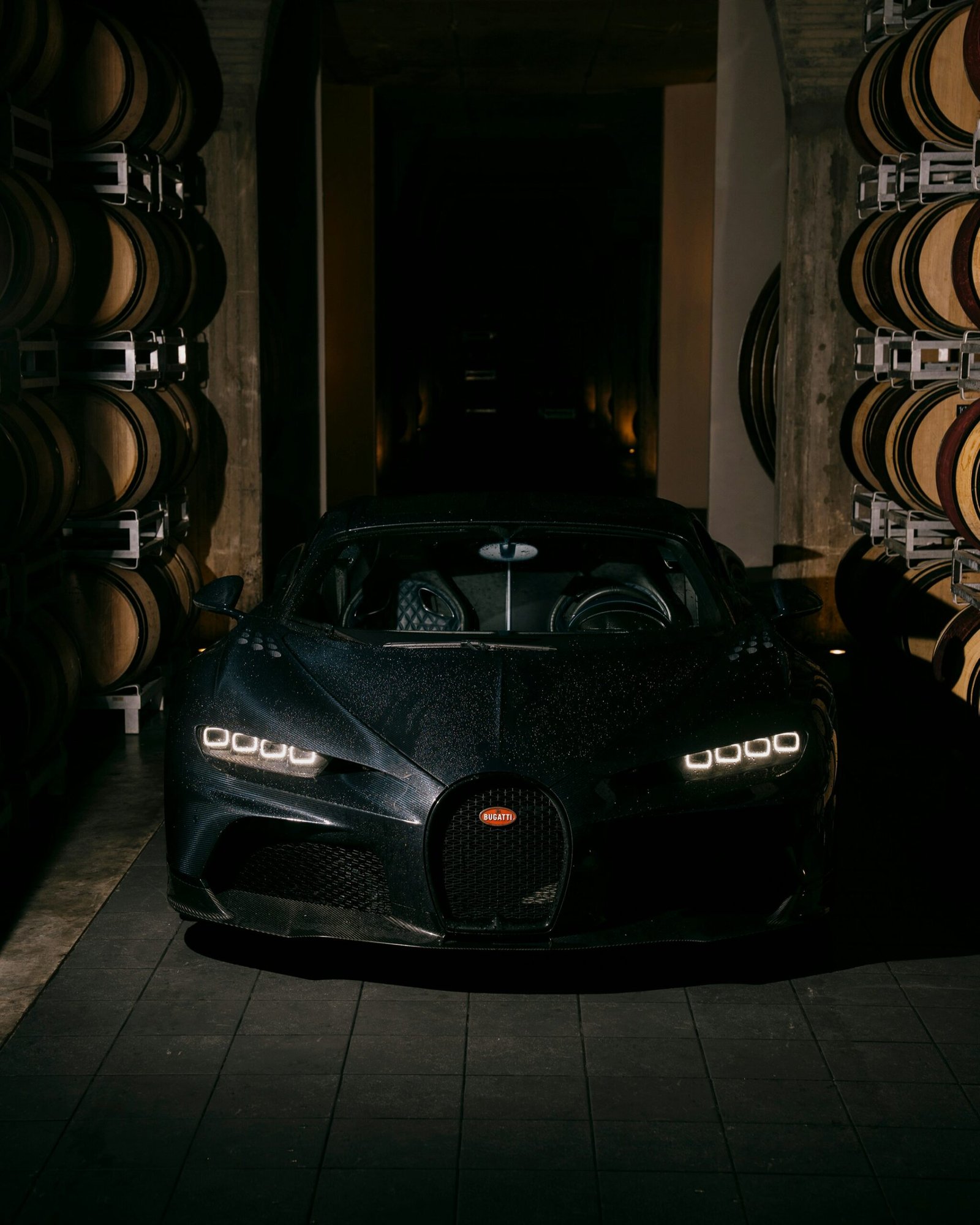
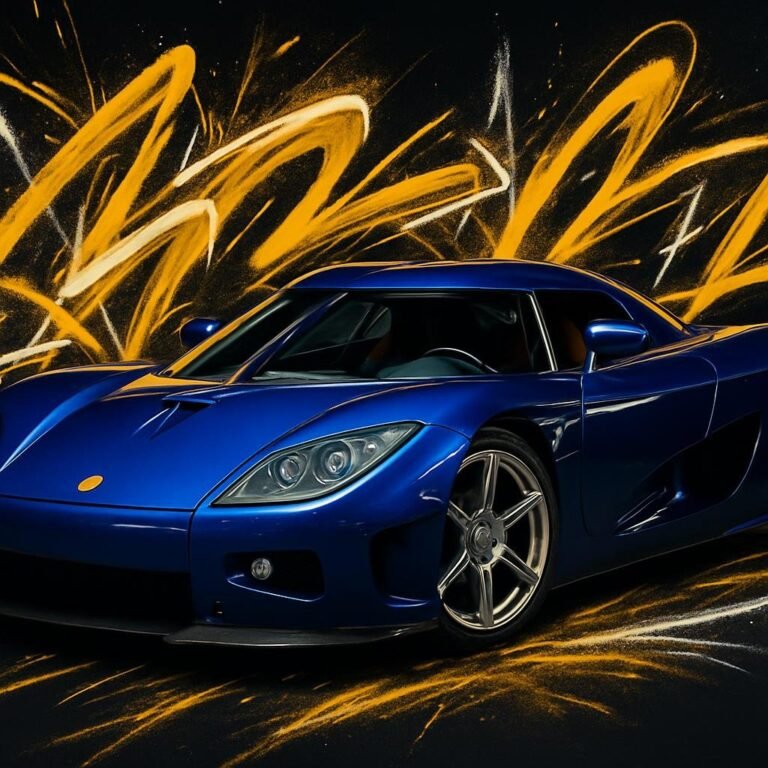
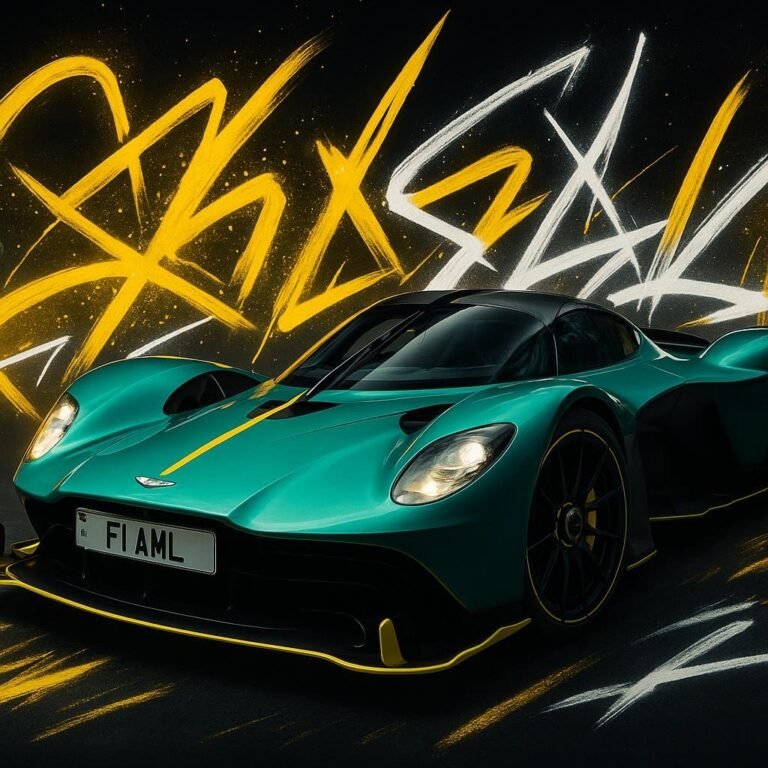
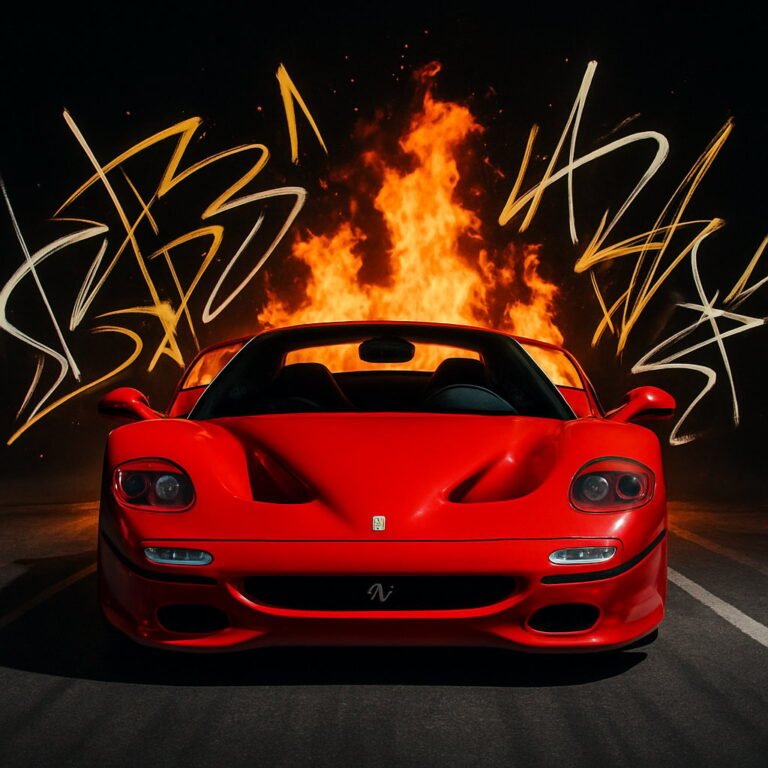
[…] Range Rover SV Coupe was the automotive world’s most expensive SUV fantasy that never got off the ground. Jaguar Land Rover axed this $295,000 luxury […]
[…] color isn’t just about looks—it’s a legit factor in resale value. The story changes even more with limited edition cars, where unique paint can make or break your […]